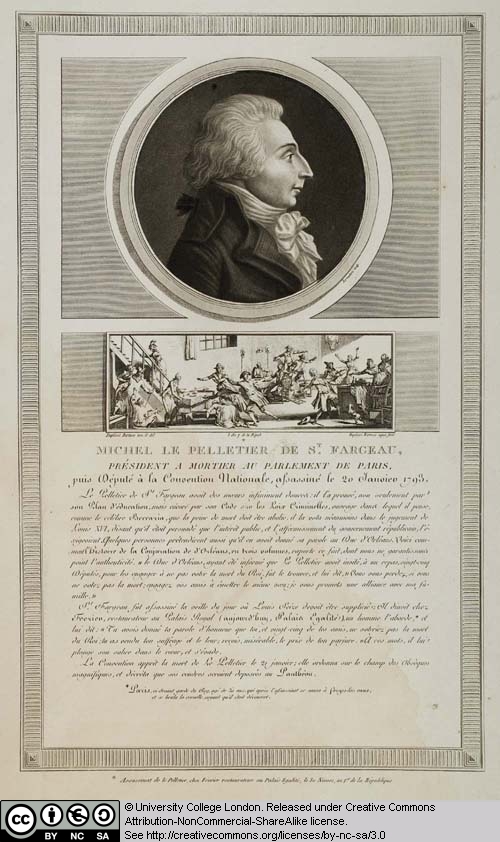20 Pelletier

Charles Francois
Gabriel Le Vachez (1760 – 1820) and Jean Duplessi-Bertaux (1747 – 1819)
Michel Le Pelletier de
St Fargeau ; Assassinat de Le Pelletier chez Février restauranteur au Palais
Égalité le 30 Nivôse, an 1èr de la République (Assassination of Le Pelletier at
Fevrier’s restaurant in the Palais Égalité, the 30th Nivose, 1st year of the
republic) , 1802
Etching, engraving and
aquatint
Published in the
series Tableaux historiques de la Révolution française, 1791 – 1817, (first
included in the edition of 1802)
The publication of the portrait of Le Pelletier was
advertised in the Journal général de la littérature de France, in Messidor an 7
(20th June – 19th July 1799), issue no. VII. It formed part of the 5th instalment
of portraits, which would eventually be included in the third volume of the
edition of 1802.
Le Pelletier is instantly recognisable as a result of Le
Vachez’s decision to show the deputy from the side, allowing him to delineate
his very distinct profile. Below, the scene of Le Pelletier’s murder at the
hands of
The accompanying text indicates that we are meant to share
their remorse at the murder of one so good. It opens with the statement that Le
Pelletier was a man of gentle manners who had campaigned for the abolition of
the death penalty. He had nevertheless voted for the execution of the king, but
by his account only because he believed it in the public interest and necessary
for the strengthening of the republican government. Yet the text expresses some
ambiguity about his motivations for having so voted, and the rumour that he had
sold his suffrage to the Duc d’Orleans (another
regicide) in return for the favours of his family, is recounted here. This
ambiguity may denote the fact that regicides such as Le Pelletier were viewed
with increasing ambivalence at the time of the publication of this print.
Licensed under the Creative Commons Attribution Non-commercial Share Alike 3.0 License
This resource has been released as an open educational resource (OER) on a Creative Commons 'Attribution Non-commercial Share Alike' license. This means that once downloaded, content can be modified and improved to complement a particular course. This requires, however, that improvements are recycled back into the OER community. All content present at the time of download must be accordingly credited and, in turn, novel content must be appropriately licensed.